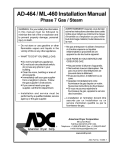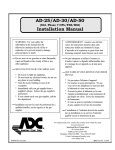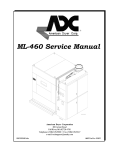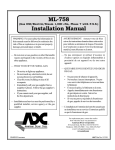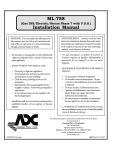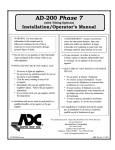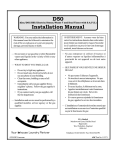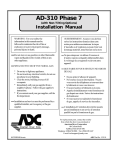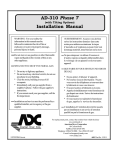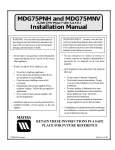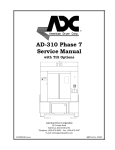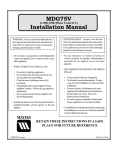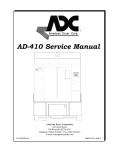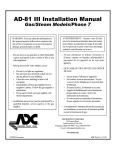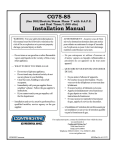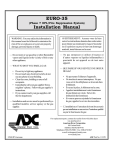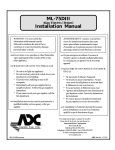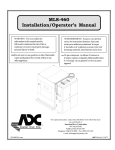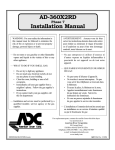Download ADC AD-464 Installation manual
Transcript
AD-464/ML-460 Phase 7 Gas/Steam Installation Manual WARNING: For your safety the information in this manual must be followed to minimize the risk of fire or explosion or to prevent property damage, personal injury or death. AVERTISSEMENT: Assurez-vous de bien suivre les instructions données dans cette notice pour réduire au minimum le risque d’incendie ou d’explosion ou pour éviter tout dommage matériel, toute blessure ou la mort. — Do not store or use gasoline or other flammable vapors and liquids in the vicinity of this or any other appliance. — Ne pas entreposer ni utiliser d’essence ni d’autres vapeurs ou liquides inflammables à proximité de cet appareil ou de tout autre appareil. — WHAT TO DO IF YOU SMELL GAS: • Do not try to light any appliance. • Do not touch any electrical switch; do not use any phone in your building. • Clear the room, building or area of all occupants. • Immediately call your gas supplier from a neighbor’s phone. Follow the gas supplier’s instructions. • If you cannot reach your gas supplier, call the fire department. — Installation and service must be performed by a qualified installer, service agency or the gas supplier. 090701DMG/mcronan — QUE FAIRE SI VOUS SENTEZ UNE ODEUR DE GAZ: • Ne pas tenter d’allumer d’appareils. • Ne touchez à aucun interrupteur. Ne pas vous servir des téléphones se trouvant dans le bâtiment. • Évacuez la pièce, le bâtiment ou la zone. • Appelez immédiatement votre fournisseur de gaz depuis un voisin. Suivez les instructions du fournisseur. • Si vous ne pouvez rejoindre le fournisseur de gaz, appelez le service des incendies. — L’installation et l’entretien doivent être assurés par un installateur ou un service d’entretien qualifié ou par le fournisseur de gaz. For replacement parts, contact the reseller from which the dryer was purchased or American Dryer Corporation 88 Currant Road Fall River MA 02720-4781 Telephone: (508) 678-9000 / Fax: (508) 678-9447 E-mail: [email protected] www.amdry.com ADC Part No. 113068 Retain This Manual In A Safe Place For Future Reference American Dryer Corporation products embody advanced concepts in engineering, design, and safety. If this product is properly maintained, it will provide many years of safe, efficient, and trouble free operation. ONLY qualified technicians should service this equipment. OBSERVE ALL SAFETY PRECAUTIONS displayed on the equipment or specified in the installation manual included with the dryer. The following “FOR YOUR SAFETY” caution must be posted near the dryer in a prominent location. FOR YOUR SAFETY POUR VOTRE SÉCURITÉ Do not store or use gasoline or other flammable vapors and liquids in the vicinity of this or any other appliance. Ne pas entreposer ni utiliser d’essence ni d’autres vapeurs ou liquides inflammables à proximité de cet appareil ou de tout autre appareil. We have tried to make this manual as complete as possible and hope you will find it useful. ADC reserves the right to make changes from time to time, without notice or obligation, in prices, specifications, colors, and material, and to change or discontinue models. The illustrations included in this manual may not depict your particular dryer exactly. Important For your convenience, log the following information: AD-464 Phase 7 DATE OF PURCHASE ________________________________ MODEL NO. __________________________________________ RESELLER’S NAME ________________________________________________________________________________________ Serial Number(s) ________________________________________________________________________________________ ________________________________________________________________________________________ ________________________________________________________________________________________ Replacement parts can be obtained from your reseller or the ADC factory. When ordering replacement parts from the factory, you can FAX your order to ADC at (508) 678-9447 or telephone your order directly to the ADC Parts Department at (508) 678-9000. Please specify the dryer model number and serial number in addition to the description and part number, so that your order is processed accurately and promptly. “IMPORTANT NOTE TO PURCHASER” Information must be obtained from your local gas supplier on the instructions to be followed if the user smells gas. These instructions must be posted in a prominent location near the dryer. IMPORTANT YOU MUST DISCONNECT AND LOCKOUT THE ELECTRIC SUPPLYAND THE GAS SUPPLY OR THE STEAM SUPPLY BEFORE ANY COVERS OR GUARDS ARE REMOVED FROM THE MACHINE TO ALLOW ACCESS FOR CLEANING, ADJUSTING, INSTALLATION, OR TESTING OF ANY EQUIPMENT PER OSHA (Occupational Safety and Health Administration) STANDARDS. “Caution: Label all wires prior to disconnection when servicing controls. Wiring errors can cause improper operation.” «Attention: Au moment de l’entretien des commandes, étiquetez tous les fils avant de les débrancher. Des erreurs de câblage peuvent entraîner un fonctionnement inadéquat et dangereux.» CAUTION DRYERS SHOULD NEVER BE LEFT UNATTENDED WHILE IN OPERATION. WARNING CHILDREN SHOULD NOT BE ALLOWED TO PLAY ON OR NEAR THE DRYER(S). CHILDREN SHOULD BE SUPERVISED IF NEAR DRYERS IN OPERATION. FOR YOUR SAFETY DO NOT DRY MOP HEADS IN THE DRYER. DO NOT USE DRYER IN THE PRESENCE OF DRY CLEANING FUMES. WARNING UNDER NO CIRCUMSTANCES should the dryer door switch, lint drawer switch, or the heat safety circuits ever be disabled. WARNING The dryer must never be operated with any of the back guards, outer tops, or service panels removed. PERSONAL INJURY OR FIRE COULD RESULT. WARNING DRYER MUST NEVER BE OPERATED WITHOUT THE LINT FILTER/SCREEN IN PLACE, EVEN IF AN EXTERNAL LINT COLLECTION SYSTEM IS USED. IMPORTANT PLEASE OBSERVE ALL SAFETY PRECAUTIONS displayed on the equipment and/or specified in the installation manual included with the dryer. Dryer must not be installed or stored in an area where it will be exposed to water or weather. The wiring diagram for the dryer is located in the front electrical control box area. IMPORTANT Dryer must be installed in a location/environment, which the ambient temperature remains between 40° F (4.44° C) and 130° F (54.44° C). Table of Contents SECTION I IMPORTANT INFORMATION ............................................................................... 3 A. Receiving and Handling ............................................................................................................... 3 B. Safety Precautions ...................................................................................................................... 4 SECTION II SPECIFICATIONS/DIMENSIONS ......................................................................... 6 A. B. C. D. Specifications (Gas) .................................................................................................................... 6 Specifications (Steam) ................................................................................................................ 7 Dimensions (Gas) ....................................................................................................................... 8 Dimensions (Steam) .................................................................................................................... 9 SECTION III INSTALLATION PROCEDURES ......................................................................... 10 A. B. C. D. E. F. G. H. I. J. K. L. Reassembly of Dryer ................................................................................................................ 10 Location Requirements ............................................................................................................. 13 Internal Air, Electrical, and Water Connections .......................................................................... 14 External Supply Connections ..................................................................................................... 20 Fresh Air Supply Requirements ................................................................................................. 23 Exhaust Requirements ............................................................................................................... 24 Steam Information .................................................................................................................... 28 Shutdown Instructions ............................................................................................................... 30 Compressed Air System ........................................................................................................... 30 Preoperational Tests ................................................................................................................. 31 Preparation For Operation/Start-Up ......................................................................................... 33 Electrical Requirements ............................................................................................................. 34 SECTION IV COMPONENT SYSTEM DESCRIPTIONS ........................................................ 37 A. B. C. D. Basket (Tumbler) Drive System ................................................................................................. 37 Main Air Blower and Heat Reclaimer System ............................................................................ 38 Gas Burner and Ignition System ................................................................................................ 40 Safety Devices .......................................................................................................................... 49 SECTION V PRE START-UP ........................................................................................................ 50 A. Preparation for Operation ......................................................................................................... 50 SECTION VI ROUTINE MAINTENANCE .................................................................................. 51 A. B. C. D. E. Cleaning ................................................................................................................................... 51 Adjustments ............................................................................................................................. 53 Lubrication ............................................................................................................................... 53 Basket (Tumbler) ...................................................................................................................... 53 Air Blower Drive System .......................................................................................................... 53 SECTION VII DATA LABEL LOCATION/INFORMATION ...................................................... 54 A. Data Label ............................................................................................................................... 54 SECTION VIII SERVICE/PARTS INFORMATION ...................................................................... 56 A. Service ..................................................................................................................................... 56 B. Parts ........................................................................................................................................ 56 SECTION IX SUPPRESSION SYSTEM ....................................................................................... 57 Installation ...................................................................................................................................... 58 Suppression System Theory of Operation ........................................................................................ 61 System Reset .................................................................................................................................. 61 OPL Suppression System Check Procedure .................................................................................... 61 Suppression System Parts Break Down .......................................................................................... 62 SECTION I IMPORTANT INFORMATION A. RECEIVING AND HANDLING The dryer is shipped in a protective stretch wrap cover with protective cardboard corners and top cover (or optional box) as a means of preventing damage in transit. Upon delivery, the dryer and packaging, and wooden skid should be visually inspected for shipping damage. If any damage whatsoever is noticed, inspect further before delivering carrier leaves. Dryers damaged in shipment. 1. ALL dryers should be inspected upon receipt and before they are signed for. 2. If there is suspected damage or actual damage, the trucker’s receipt should be so noted. 3. If the dryer is damaged beyond repair, it should be refused. Those dryers which were not damaged in a shipment should be accepted, but the number received and the number refused must be noted on the receipt. 4. If you determine that the dryer was damaged after the trucker has left your location, you should call the delivering carrier’s freight terminal immediately and file a claim. The freight company considers this concealed damage. This type of freight claim is very difficult to get paid and becomes extremely difficult when more than a day or two passes after the freight was delivered. It is your responsibility to file freight claims. Dryer or parts damaged in transit cannot be claimed under warranty. 5. Freight claims are the responsibility of the consignee, and ALL claims must be filed at the receiving end. ADC assumes no responsibility for freight claims or damages. 6. If you need assistance in handling the situation, please contact the ADC Traffic Manager at (508) 678-9000. IMPORTANT: The basket (tumbler) section of the dryer must be transported and handled in an upright position at ALL times. 3 B. SAFETY PRECAUTIONS WARNING: For your safety, the information in this manual must be followed to minimize the risk of fire or explosion or to prevent property damage, personal injury, or loss of life. WARNING: The dryer must never be operated with any of the back guards, outer tops, or service panels removed. PERSONAL INJURY OR FIRE COULD RESULT. 1. DO NOT store or use gasoline or other flammable vapors and liquids in the vicinity of this or any other appliance. 2. Purchaser or user should consult the local supplier for proper instructions to be followed in the event the user smells gas. The instructions should be posted in a prominent location. 3. WHAT TO DO IF YOU SMELL GAS... a. DO NOT try to light any appliance. b. DO NOT touch any electrical switch. c. DO NOT use any phone in your building. d. Clear the room, building or area of ALL occupants. e. Immediately call your gas supplier from a neighbor’s phone. Follow the gas supplier’s instructions. f. If you cannot reach your gas supplier, call the fire department. 4. Installation and service must be performed by a qualified installer, service agency or gas supplier. 5. Dryers must be exhausted to the outdoors. 6. Although ADC produces a very versatile dryer, there are some articles that, due to fabric composition or cleaning method, should not be dried in it. WARNING: Dry only water washed fabrics. DO NOT dry articles spotted or washed in dry cleaning solvents, a combustible detergent or “all purpose” cleaner. EXPLOSION COULD RESULT. WARNING: DO NOT dry rags or articles coated or contaminated with gasoline, kerosene, oil, paint, or wax. EXPLOSION COULD RESULT. WARNING: DO NOT dry mop heads. Contamination by wax or flammable solvents will create a fire hazard. WARNING: DO NOT use heat for drying articles that contain plastic, foam, sponge rubber or similarly textured rubber materials. Drying in a heated basket (tumbler) may damage plastics or rubber and may be a fire hazard. 4 IMPORTANT: Dryer must be installed in a location/environment, which the ambient temperature remains between 40º F (4.44º C) and 130º F (54.44º C). 7. A program should be established for the inspection and cleaning of lint in the heating unit area, exhaust ductwork, and inside the dryer. The frequency of inspection and cleaning can best be determined from experience at each location. WARNING: The collection of lint in the burner area and exhaust ductwork can create a potential fire hazard. 8. For personal safety, the dryer must be electrically grounded in accordance with local codes and/or the National Electrical Code ANSI/NFPA NO. 70-LATEST EDITION or in Canada, the Canadian Electrical Codes Parts 1 & 2 CSA C22.1-1990 or LATEST EDITION. NOTE: Failure to do so will VOID THE WARRANTY. 9. UNDER NO CIRCUMSTANCES should the dryer door switch, lint drawer switch, or the heat safety circuits ever be disabled. WARNING: PERSONAL INJURY OR FIRE COULD RESULT. 10. This dryer is not to be used in the presence of dry cleaning solvents or fumes. 11. Remove articles from the dryer as soon as the drying cycle has been completed. WARNING: Articles left in the dryer after the drying and cooling cycles have been completed can create a fire hazard. 12. DO NOT operate steam dryers with more than 125 PSI (8.61 bar) steam pressure. Excessive steam pressure can damage steam coil and/or harm personnel. 13. Replace leaking flexible hoses or other steam fixtures immediately. DO NOT operate the dryer with leaking flexible hoses. PERSONAL INJURY MAY RESULT. 14. READ AND FOLLOW ALL CAUTION AND DIRECTION LABELS ATTACHED TO THE DRYER. 15. For safety, proper operation, and optimum performance, the dryer must not be operated with a load less than sixty-six percent (66%), 303 lbs (137.4 kg) of its rated capacity. WARNING: YOU MUST DISCONNECT AND LOCKOUT THE ELECTRIC SUPPLY AND THE GAS SUPPLY OR THE STEAM SUPPLY BEFORE ANY COVERS OR GUARDS ARE REMOVED FROM THE MACHINE TO ALLOW ACCESS FOR CLEANING, ADJUSTING, INSTALLATION, OR TESTING OF ANY EQUIPMENT PER OSHA (Occupational Safety and Health Administration) STANDARDS. 5 SECTION II SPECIFICATIONS/DIMENSIONS A. SPECIFICATIONS (GAS) 460 lbs 209.09 kg TOTAL WEIGHT 10,270 lbs 4,658.47 kg TOTAL SHIPPING WEIGHT 10,425 lbs 4,728.78 kg TILT HEIGHT 137-1/4” 348.6 cm OPERATING HEIGHT 114-1/2” 290.83 cm FULL TILT DEPTH 117-1/2” 298.45 cm OPERATING DEPTH 95” 241.3 cm WIDTH 122” 309.88 cm MAXIMUM CAPACITY (DRY WEIGHT) TILT LOAD (REAR TILT) 15° TILT UNLOAD (FRONT TILT) 15° UNLOADING HEIGHT FROM FLOOR 43-3/4” 111.12 cm LOADING HEIGHT FROM FLOOR 65-5/8” 166.69 cm DOOR OPENING 53-1/4” X 49” 135.26 cm x 124.46 cm BASKET (TUMBLER) DIAMETER 69-1/8” 175.58 cm BASKET (TUMBLER) DEPTH 80-5/16” 203.99 cm BASKET (TUMBLER) VOLUME 175 cu.ft. 4.96 cu. m. MINIMUM LOAD SIZE 250 lbs 113.64 kg MAXIMUM LOAD SIZE 460 lbs 209.09 kg BURNER TYPE ON/OFF 2,800,000 btu/hr 705,290 kcal/hr 25 HP 18.64 kw DRIVE MOTOR 7-1/2 HP 5.6 kw BURNER BLOWER MOTOR 1-1/2 HP 1.12 kw AIRFLOW 13,000 cfm 368 cmm MAXIMUM HEAT INPUT* BLOWER MOTOR GAS INLET CONNECTION 2-1/2” F.P.T. 1.25” (wc) 3.1 mb 24” 60.96 cm COMPRESSED AIR PRESSURE REQUIRED 80 PSI (± 10 PSI) 5.51 bar (± 0.68 bar) COMPRESSED AIR VOLUME REQUIRED 20 cfh 0.57 cmh MAXIMUM DUCT BACK PRESSURE MINIMUM DUCT PRESSURE COMPRESSED AIR CONNECTION 3/8” N.P.T. Shaded areas are stated in metric equivalents * Gas pressure into the dryer cannot exceed 13 inches (32.34 mb) water column (W.C.). If the gas pressure is higher than 13 inches (32.34 mb) W.C., an external regular must be installed. NOTE: ADC reserves the right to make changes in specifications at any time without notice or obligation. 6 B. SPECIFICATIONS (STEAM) 460 lbs 209.09 kg TOTAL WEIGHT 10,500 lbs 4,762.7 kg TOTAL SHIPPING WEIGHT 10,800 lbs 4,898.8 kg TILT HEIGHT 137-1/4” 348.6 cm OPERATING HEIGHT 114-1/2” 290.83 cm FULL TILT DEPTH 117-1/2” 298.45 cm OPERATING DEPTH 95” 241.3 cm WIDTH 122” 309.88 cm MAXIMUM CAPACITY (DRY WEIGHT) TILT LOAD (REAR TILT) 15° TILT UNLOAD (FRONT TILT) 15° LOADING HEIGHT FROM FLOOR 65-5/8” 166.69 cm BASKET (TUMBLER) DIAMETER 69-1/8” 175.58 cm BASKET (TUMBLER) DEPTH 80-5/16” 203.99 cm BASKET (TUMBLER) VOLUME 175 cu. ft. 4.96 cu. m. MINIMUM LOAD SIZE 250 lbs 113.64 kg MAXIMUM LOAD SIZE 460 lbs 209.09 kg BLOWER MOTOR 25 HP 18.64 kw (2) 5 HP (2) 3.73 kw BASKET (TUMBLER) MOTOR BOILER HORSEPOWER 60 BHP BURNER BLOWER MOTOR 1-1/2 HP 1.12 kw AIRFLOW 13,000 cfm 368 cmm STEAM INLET SIZE CONNECTION 2” N.P.T. 1.25” (wc) 3.1 mb 24” 60.96 cm COMPRESSED AIR PRESSURE REQUIRED 80 PSI (± 10 PSI) 5.51 bar (± 0.68 bar) COMPRESSED AIR VOLUME REQUIRED 20 cfh 0.57 cmh MAXIMUM DUCT BACK PRESSURE MINIMUM DUCT PRESSURE COMPRESSED CONNECTION 3/8” N.P.T. Shaded areas are stated in metric equivalents NOTE: ADC reserves the right to make changes in specifications at any time without notice or obligation. 7 C. DIMENSIONS (GAS) NOTE: ADC reserves the right to make changes in specifications at any time without notice or obligation. 8 D. DIMENSIONS (STEAM) NOTE: ADC reserves the right to make changes in specifications at any time without notice or obligation. 9 SECTION III INSTALLATION PROCEDURES Installation should be performed by competent technicians in accordance with local and state codes. In the absence of these codes, the installation must conform to applicable American National Standards: ANSI Z223.1LATEST EDITION (National Fuel Gas Code) or ANSI/NFPA NO. 70-LATEST EDITION (National Electrical Code) or in Canada, the installation must conform to applicable Canadian Standards: CAN/CGA-B149.1-M91 (Natural Gas) or CAN/CGA-B149.2-M91 (Liquid Propane [L.P.] Gas) or LATEST EDITION (for General Installation and Gas Plumbing) or Canadian Electrical Codes Parts 1 & 2 CSA C22.1-1990 or LATEST EDITION (for Electrical Connections). A. REASSEMBLY OF DRYER IMPORTANT: Always keep the basket (tumbler) section of the dryer in an upright position when moving it. 1. Reassembly Instructions for Dryer Shipped in Two (2) Pieces In this method of shipment, the basket (tumbler) section and the basket (tumbler) base section are shipped as one (1) unit and the heat console section is the second. a. Reassemble Basket (tumbler) and Basket (tumbler) Base Section To The Heat Console Section Move both pieces into position by lifting them with cables through the eyebolts located at the top of each of the two (2) sections. These pieces may also be moved into place with a forklift truck by lifting the pieces from underneath. The basket (tumbler) and basket (tumbler) base section weighs about 6,400 pounds (2,903 kg) and the heat console section weighs about 4,100 lbs (1,860 kg). Once the sections are in position, the seven (7) clearance holes on the basket (tumbler) base section (four [4] in the front and three [3] in the rear) must be aligned with the seven (7) 3/8-16 tapped holes in the heat console section. Use the three (3) #8-16 x 2” long bolts along with the tapered shims supplied to bolt the two (2) sections together. b. Reattach The Optional Control Pendant Arm Position the control pendant arm to the top front of the heat console section by aligning the clearance holes in the arm with the 1/4-20 tapped holes on the top of the heat console section. Use the 1/4-20 x 3” long bolts supplied with the dryer to attach the arm to the console. c. Reconnect The Internal Air, Electric, and Water Connections (refer to page 14 through page 19). 2. Reassembly Instructions for Dryers Shipped In Three (3) Pieces When the dryer is shipped in three (3) pieces, the basket (tumbler) and the basket (tumbler) base sections are shipped as two (2) separate pieces. The heat console section is shipped as the third piece. 10 a. Reassemble The Basket (tumbler) Base Section To The Heat Console Section Move the heat console section into position by using cables through the eyebolts located at the top of the section or by using a forklift truck and lifting the section from underneath. The basket (tumbler) base section is now moved into position with a forklift truck. The seven (7) clearance holes located on the right side of the basket (tumbler) base section (four [4] holes in front and three [3] at the back of the section) must be aligned with the seven (7) 3/8-16 tapped holes on the left side of the heat console section. Use the 3/8-16 x 3” long bolts and the tapered shims supplied with the unit to bolt the section together. b. Reassemble The Basket (tumbler) Section Over The Basket (tumbler) Base Slowly lower the basket (tumbler) section over the basket (tumbler) base. The four (4) large slots located on the bottom of the basket (tumbler) section (one [1] slot at each corner of the basket [tumbler] section) must be aligned with the top of the pistons in the basket (tumbler) base section. Use the four (4) 1-1/4-12 x 3-1/2” long bolts supplied with the unit to secure the basket (tumbler) section to the basket (tumbler) base section. c. Reattach The Control Pendant Arm Position the control pendant arm to the top front of the heat console section by aligning the clearance holes in the arm with the 1/4-20 tapped holes on the top of the heat console section. Use the 1/4-20 x 3” long bolts supplied with the dryer to attach the arm to the console. d. Reconnect The Internal Air, Electric, and Water Connections (refer to page 14 through page 19). 3. Reassembly Instructions for Dryer Shipped in Four (4) Pieces In this method of shipment the basket (tumbler) section, basket (tumbler) base, lower heat console, and upper heat console are ALL shipped as separate sections. a. Reassemble The Heat Console Section Apply silicone (provided with unit) to the flanges of the lower heat console section. Lift the upper heat console section by use of cables through the eyebolts located on the top of the upper console section. Position the upper heat console over the lower heat console section. Use the 5/16-18 hardware provided with the dryer to secure the sections together. b. Reassemble The Basket (tumbler) Base Section To The Heat Console Section Move the heat console section into position by using cables through the eyebolts located at the top of the section or by using a forklift truck and lifting the section from underneath. The basket (tumbler) base section is now moved into position with a forklift truck. The seven (7) clearance holes located on the right side of the basket (tumbler) base section (four [4] holes in the front and the three [3] at the back of the section) must be aligned with the seven 3/8-16 tapped holes on the left side of the heat console section. Use the 3/8-16 x 2” long bolts and the tapered shims supplied with the unit to bolt the sections together. 11 c. Reassemble The Basket (tumbler) Section To The Basket (tumbler) Base Lift the basket (tumbler) section with a cable through the eyebolts on top of the section. Slowly lower the basket (tumbler) section over the basket (tumbler) base. The four (4) large slots located on the bottom of the basket (tumbler) section (one [1] slot at each corner of the basket [tumbler] section) must be aligned with the tapped holes in the cylinder cleaves located at the top of the basket (tumbler) section. Use the four (4) 1-1/4-12 x 3-1/2” long bolts supplied with the unit to secure the basket (tumbler) section to the basket (tumbler) base section. d. Reattach The Control Pendant Arm Position the control pendant arm on the top front of the heat console section by aligning the clearance holes in the arm over the 1/4-20 taped holes in the top of the heat console section. Use the 1/4-20 x 3” long bolts supplied with the unit to attach the arm to the console. e. Reconnect The Internal Air, Electric, and Water Connections (refer to page 14 through page 19). 12 B. LOCATION REQUIREMENTS Before installing the dryer, be sure the location conforms to local codes and ordinances. In the absence of such codes or ordinances the location must conform with the National Fuel Gas Code ANSI.Z223.1 LATEST EDITION, or in Canada, the installation must conform to applicable Canadian Standards: CAN/CGA-B149.1M91 (Natural Gas) or CAN/CGA-B149.2-M91 (Liquid Propane [L.P.] Gas) or LATEST EDITION (for General Installation and Gas Plumbing). The dryer requires 36-inches (91.44 cm) of space on each side of the dryer and 36-inches (91.44 cm) of space behind the unit for ease of maintenance and tilting. The dryer must be leveled for proper operation. If shimming is required, put 9-1/2” x 9-1/2” (24.13 cm x 24.13 cm) metal shims under the base feet. The dryer must be lagged to the floor. IMPORTANT: Dryer should be located where a minimum amount of exhaust duct will be necessary. 1. The dryer must be installed with a proper exhaust duct connection to the outside. 2. The dryer must be installed with provisions for adequate combustion and make-up air supply. CAUTION: This dryer produces combustible lint and must be exhausted to the outdoors. Every 6 months, inspect the exhaust ducting and remove any lint build up. IMPORTANT: Dryer must be installed in a location/environment, which the ambient temperature remains between 40º F (4.44º C) and 130º F (54.44º C). 13 C. INTERNAL AIR, ELECTRIC, AND WATER CONNECTIONS 1. Air a. Front Tilt Piston This connection is made at the front of the dryer in the area between the lower heat console section and the basket (tumbler) base section. To connect the 3/8” poly-flo tubing to the corresponding brass fittings, match the marked number on the tube with the number on the brass fitting. After inserting the corresponding tubes into the brass fittings, tighten the brass fitting nuts. b. Rear Tilt Piston Lines This connection is made at the rear of the dryer in the space between the lower heat console section and the basket (tumbler) base section. Insert the 3/8” poly-flo tube coming from the basket (tumbler) base section to the 3/8” brass fitting marked with the corresponding number. Do the same to the second tube and brass fitting. Tighten the brass fitting nuts. 14 c. Load Door Piston Lines The load door cylinder pneumatic connections are made in the lower heat console section, in the area behind the pneumatic panel. To connect the 1/4” poly-flo tubing into the corresponding needle valves, match the number on the line with the number on the needle valve. Insert ALL of the tubing (two [2] on a 1-door model, four [4] on a 2-door model) into their corresponding valves. Give a moderate pull on ALL of the air lines to make sure that the connections are complete. 15 2. Electric a. Basket (tumbler) Motors The disconnects for the one (1) basket (tumbler) motor is located in the lower heat console. The left drum (basket [tumbler]) motor disconnect is located in the base of the lower heat console to the right. On the cable the mechanical connection should be made to the respective junction box. Remove the two (2) screws that hold down the cover to each junction box. Insert cable end in the junction box and fasten with lock nut. Then, begin to connect the four (4) wires with the same color tape identifiers together with the four (4) wires already in the junction box. Make these connections with wire nuts and PVC electrical tape. Replace the cover and the two (2) cover screws that hold down the cover to the junction box. b. Temperature Probe, Base, and Basket (tumbler) Disconnects The disconnects are located in the lower heat console. The temperature probe disconnect is located on the upper shelf towards the left. The base disconnect and the basket (tumbler) disconnect are located on the base towards the right. Check identifying tapes to ensure proper assignments of connectors to the proper base. Check for proper keying and connect disconnect to the proper base. Engage hold downs on base and verify that the clamps are properly locked. 16 c. Annunciator, Optional Pendant, Over-Burner, and Resistance Temperature Detector (RTD) Cable Remove the four (4) bolts that hold on the character panel. Open the door to the main electrical enclosure, the female end of the RTD cable will be found there. Loosen the 1-inch lock nut and remove the modified hole seal. Put the female end of the RTD cable through the hole in the top of the electrical enclosure. Connect the male end and the female end of the RTD cable together, pull the cable up until the threads of the reducing bushing can be seen through the hole into where the character panel was. Next, get the 1-inch lock nut on by a few threads, slip the modified hole seal under the lock nut holding the 45° cord grip connector, then tighten the 1-inch lock nut. Replace the character panel and tighten the four (4) bolts. 17 d. Optional Pendant On the top of the heat console section of the dryer near the pendant, there is a junction box with four (4) cables coming out of it. Two (2) of the cables from the junction box have connectors on the end, a 5-pin connector and an 11-pin connector. Coming out of the pendant should be two (2) cables, one (1) with a 5-pin connector and the other with an 11-pin connector. Match up the four (4) cables into assigned pairs, check keying and connect the male and female connection together. 18 e. Basket (tumbler) Junction Box Disconnect Remove the four (4) bolts that hold on the lower left side panel, then remove the panel. The safety panel is next to be removed. This is done by removing the six (6) bolts on the bottom of the safety panel where the basket (tumbler) section and the base meet. Reach into the feed through hole in the base of the basket (tumbler) section, there will be two (2) cables there. Pull both cables through the hole into the basket (tumbler) section. The cable with the connector on the end is for the basket (tumbler) junction box, the other cable is for the left drum motor. Leave that cable in the basket (tumbler) section (it will be covered in Section F [Left Drum Motor] below). Check keying between the plug and basket (tumbler) junction box. Insert plug into connector on the junction box and engage locking clasps. Leave the lower left side panel and the safety panel off the dryer until left drum motor is reconnected (refer to Section F [Left Drum Motor] below). f. Left Drum Motor There are two (2) different ways that the left drum motor is connected with or without the motor disconnect junction box. The junction box is used when the connections to the left motor are made on the back side of the motor, nearest to the basket (tumbler). When connecting the motor, bring the left drum motor cable (refer to Section E Basket [tumbler] Junction Box Disconnect] above) and mechanically connect it to the junction box on the motor or the external junction box with the lock nut. There will be four (4) wires in the cable, match them with the PVC electrical tape. There should be one (1) green wire remaining, which is used for the ground connection. Replace the screws that go on the cover of the junction box. Bolt the safety panel back in place using the six (6) bolts removed in Section E (Basket [tumbler] Junction Box Disconnect above), then bolt the lower left side panel back in to place using the four (4) bolts also removed in Section E (Basket [tumbler] Junction Box Disconnect above). 19 D. EXTERNAL SUPPLY CONNECTIONS 1. Compressed Air Supply A minimum requirement of 20 cfh (0.57 cmh) at 80 PSI (5.51 bar) of dry, clean and regulated compressed air must be supplied to the dryer. The compressed air supply must be connected into the 3/8” F.P.T. fitting which is located in the rear corner of the lower heat console section. 20 2. Gas Piping The gas connection to the dryer is made into the 2-1/2” F.P.T. shutoff valve located in the bottom front corner of the lower heat console. The gas pressure supplied to the dryer must be between 7 inches (17.41 mb) and 13 inches (32.34 mb) water column (W.C.) for natural gas or 10.5 inches (26.12 mb) water column (W.C.) for liquid propane (L.P.) gas. If the facilities gas pressure is higher than these values, an external pressure regulator must be installed prior to the dryer to reduce the gas pressure to within the appropriate range. The dryer must be connected to either natural or L.P. gas indicated on the dryer data label which is located in the right hand side of the main electrical enclosure. If your gas supply does not match the type of gas for which the dryer was built, contact your reseller or the ADC factory. a. The gas dryer installation must meet the American National Standard...National Fuel Gas Code ANSI Z223.1-LATEST EDITION, or in Canada, the Canadian Installation Codes CAN/CGA-B149.1 M91 (Natural Gas) or CAN/CGA-B149.2-M91 (L.P. Gas) or LATEST EDITION, as well as local codes and ordinances and must be done by a qualified professional. b. The dryer and its individual shutoff valve must be disconnected from the gas supply piping system during any pressure testing of that system at test pressures in excess of 1/2 PSI (3.5 kPa). Pipe joint compounds that resist the action of natural and L.P. gas must be used. Test ALL pipe connections for leaks by brushing on a soapy water solution. WARNING: NEVER TEST FOR LEAKS WITH A FLAME!!! NOTE: Venting must be controlled in accordance with government and plumbing codes and regulations to avoid the danger of escaping gas should there be internal leakage. Vent pipes must be open and the open end protected against entry of foreign matter, including water. 21 3. Steam Supply and Condensate Return Connections The steam supply line into the dryer is made into the 2-1/2” F.P.T. pipe fitting located on top of the heat module console. The maximum operating steam supply pressure is 150 psig (1,034 kPa). The presence of condensate in the steam supply line will cause water hammer and subsequent steam coil (battery) failure. The steam supply connection out of the main supply line must be made with a minimum 10-inch (25.4 cm) riser. This will reduce the amount of condensate in the steam supply. Use flexible couplings at the supply and return connections. The dryer vibrates slightly when it runs and the piping connections may crack if they are hard piped to the dryer. Install shutoff valves in the supply and return lines. An inverted bucket steam trap with an internal check valve is included with the dryer. The supply lines should be insulated. This will save energy and provide for the safety of the operator and maintenance personnel. Water pockets in the supply line, caused by low points, will provide wet steam to the coil possibly causing steam coil damage. ALL horizontal runs of steam supply piping should be pitched 1/4-inch (6.35 mm) for the header. Install a bypass trap in any low point to eliminate wet steam. The condensate return line must be 1-1/4” pipe. 22 E. FRESH AIR SUPPLY REQUIREMENTS When the dryer is operating, it draws in room air, heats this air through the basket (tumbler), and exhausts it out of the building. Therefore, the room air must be continually replenished from the outdoors. If make-up air is inadequate, drying time and efficiency will be adversely affected, and safety will be compromised. Premature component failure may result. Air supply (make-up air) must be given careful consideration to assure proper performance of each dryer. An unrestricted source of air is necessary for each dryer. An airflow of 13,000 cfm (368 cmm) must be supplied to each dryer. As a general rule, an unrestricted air entrance from the outdoors (atmosphere) of a minimum 20 square feet (6.096 square meters) is required for each dryer. To compensate for the use of registers or louvers used over the openings, the make-up air area must be increased by approximately thirty-three percent (33%). Make-up air openings should not be located in an area directly near where exhaust vents exit the building. Allowances must be made for remote or constricting passageways or where dryers are located at excessive altitude or predominantly low pressure areas. The dryer must be installed with provisions for adequate combustion and make-up air supply. IMPORTANT: Make-up air must be provided from a source free of dry cleaning solvent fumes. Make-up air that is contaminated by dry cleaning solvent fumes will result in irreparable damage to the motors and other dryer components. NOTE: Component failure due to dry cleaning solvent fumes will VOID THE WARRANTY. 23 F. EXHAUST REQUIREMENTS 1. General Exhaust Ductwork Information Exhaust ductwork should be designed and installed by a qualified professional. Improperly sized ductwork will create excessive back pressure which results in slow drying, increased use of energy, overheating of the dryer, and shutdown of the burner by the airflow (sail) switches, burner hi-limits, or basket (tumbler) hi-limit thermostats. The dryer must be installed with a proper exhaust duct connection to the outside. CAUTION: This dryer produces combustible lint and must be exhausted to the outdoors. CAUTION: IMPROPERLY SIZED OR INSTALLED EXHAUST DUCTWORK CAN CREATE A POTENTIAL FIRE HAZARD. NOTE: THE DRYER MUST BE INDEPENDENTLY EXHAUSTED. COMMON DUCTWORK IS NOT ACCEPTABLE. The exhaust ductwork should be laid out in such a way that the ductwork travels as directly as possible to the outdoors with as few turns as possible. Single or independent dryer venting is recommended. The shape of the ductwork is not critical so long as the minimum cross section area is provided. It is suggested that the use of 90º turns in ducting be avoided; use 30º and/or 45º angles instead. The radius of the elbow should preferably be 1-1/2 times the diameter of the duct. ALL ductwork should be smooth inside with no projections from sheet metal screws or other obstructions, which will collect lint. When adding ducts, the ducts to be added should overlap the duct to which it is connected. ALL ductwork joints must be taped to prevent moisture and lint from escaping into the building. Additionally, inspection doors should be installed at strategic points in the exhaust ductwork for periodic inspection and cleaning of lint from the ductwork. The internal dimensions of the dryer’s square exhaust vent ductwork is 18-inches x 18-inches (45.72 cm x 45.72 cm). A transition piece to 24-inches (60.96 cm) in diameter round is supplied. The location’s exhaust duct must be the minimum exhaust size requirement of (24-inches [60.96 cm] round duct or 460 square inches [2,968 square centimeters] square duct) the ductwork from the dryer to the outside exhaust outlet for a horizontal run with no more than one (1) elbow must not exceed 30 feet (9.14 meters) for gas and steam dryers (refer to the illustrations on page 26). For locations with more than one (1) elbow, the minimum exhaust size for gas and steam models must use a 28-inch (71.12 cm) round duct (650 square inches [4,194 square centimeters] duct) must be used. The horizontal or vertical duct total run on gas and steam models must not exceed 35 feet (10.67 meters), which includes the use of no more than four (4) elbows (refer to the illustrations on page 25). IMPORTANT: For extended ductwork runs or where more than the specified number of elbows are used, a professional heating, venting, and air conditioning (HVAC) firm should be contacted for proper venting information. IMPORTANT: It is recommended that exhaust or booster fans not be used in the exhaust ductwork system. NOTE: Exhaust ducts for type 2 clothes dryers shall be constructed of sheet metal or other noncombustible material. Such ducts shall be equivalent in strength and corrosion resistance to ducts made of galvanized sheet steel not less than 26 gauge (0.0195 in) (0.5 mm) thick. 24 25 26 a. Outside Ductwork Protection 1) To protect the outside end of the horizontal ductwork from the weather, a 90º elbow bent downward should be installed where the exhaust exits the building. If the exhaust ductwork travels vertically up through the roof, it should be protected from the weather by using a 180º turn to point the opening downward. In either case, allow at least twice the diameter of the duct between the duct opening and nearest obstruction. IMPORTANT: DO NOT use screens, louvers, or caps on the outside opening of the exhaust ductwork. NOTE: Exhaust back pressure measured by a manometer at the dryer exhaust duct area must be no less than 0 and must not exceed 1.25 inches (3.11 mb) of water column (W.C.) NOTE: When the exhaust ductwork passes through a wall, ceiling, or roof made of combustible materials, the opening must be 2-inches (5.08 cm) larger than the duct (all the way around). The duct must be centered within this opening. 27 G. STEAM INFORMATION It is your responsibility to have ALL plumbing connections made by a qualified professional to assure that the steam plumbing installation is adequate and conforms with local and state regulations or codes. IMPORTANT: Failure to comply with the requirements stipulated in this manual can result in component failure, which will VOID THE WARRANTY. NOTE: The dryer is manufactured with a pneumatic (piston) damper system, which requires an external supply of clean, dry, and regulated air (80 PSI +/- 10 PSI [5.51 bar +/- 0.68 bar]). 1. Steam Coil PH Level The normal for copper type steam coils must be maintained between a value of 8.5 to 9.5. For steel type steam coils the PH level must be maintained between a value of 9.5 to 10.5. These limits are set to limit the acid attack of the steam coils. IMPORTANT: Coil failure due to improper PH level will VOID THE WARRANTY. 2. Steam Requirements - High Pressure Inlet---------2” supply line connection Return------1-1/4” return line connection OPERATING STEAM PRESSURE MAXIMUM 150 psig 862 kPa MINIMUM 100 psig 690 kPa 60 BHP HEAT INPUT (NORMAL LOAD) CONSUMPTION(APPROXIMATE) 1,980 lbs/hr 898 kg/hr Shaded areas are stated in metric equivalents 3. Installation Instructions To insure that adequate supply of steam is provided, be sure that the steam supply lines and steam return lines are sized and laid out as stipulated in this manual. Inadequate steam supply lines and steam return lines or improper steam plumbing will result in poor performance and can cause component failure. Clean, dry, and regulated steam must be provided to the dryer. IMPORTANT: Steam coil failure due to water hammer by wet steam will VOID THE WARRANTY. a. The presence of the condensate in the steam supply will cause water hammer and subsequent heat exchanger (steam coil) failure. The steam supply connection into the main supply line must be made with a minimum 10-inch (25.4 cm) riser. This will prevent any condensate from draining towards the dryer. 28 b. The steam supply line to the dryer must include a 12-inch (30.48 cm) riser along with a drip trap and check valve. This will prevent any condensate from entering the steam coil. c. Flexible hoses or couplings must be used. The dryer vibrates slightly when it runs and this will cause the steam coil connections to crack if they are hard piped to the supply and return mains. d. Shutoff valves for each dryer should be installed in the supply, return, and drip trap return lines. This will allow the dryer to be isolated from the supply and return mains if the dryer needs maintenance work. e. Install an inverted bucket steam trap which will pass 2,700 lbs (1224.69 kg) at 125 PSI (8.61 bar) and check valve for each unit at least 12-inches (30.48 cm) below steam coil as close to the coil as possible. f. The supply and return lines should be insulated. This will save energy and provide for safety of the operator and maintenance personnel. g. Water pockets in the supply line, caused by low points, will provide wet steam to the coil possibly causing coil damage. ALL horizontal runs of steam supply piping should be pitched 1/4-inch (6.35 mm) for every 1 foot (0.30 meters) back towards the steam supply header causing any condensate in the line to drain the header. Install a bypass trap in any low point to eliminate wet steam. 29 H. SHUTDOWN INSTRUCTIONS If the dryer is to be shutdown (taken out of service) for a period of time, the following must be performed: 1. Discontinue power to the dryer either at the external disconnect switch or the circuit breaker. 2. Discontinue the heat supply: a. GAS MODELS...discontinue the gas supply. 1) SHUT OFF external gas supply shutoff valve. 2) SHUT OFF internal gas supply shutoff valve located in the gas valve burner area. b. STEAM MODELS...discontinue the steam supply. 1) SHUT OFF external (location furnished) shutoff valve. 2) SHUT OFF internal steam valves in the supply lines and the return lines. I. COMPRESSED AIR SYSTEM The compressed air system of the dryer consists of a number of pneumatic pistons located throughout the dryer, a Filter/Regulator assembly, and pneumatic control panel. 1. Air Pistons: The pistons are actuated by solenoid and flow control valves that are under computer control. The pneumatic pistons are used to: • • • • Tilt the dryer for loading and unloading. Open and close load and unload doors. Operate heat reclaimer. Operate the cool down damper and the intake air damper. 2. Filter/Regulator Assembly The compressed air supply to the dryer is connected into the 3/8” F.P.T. fitting located on the rear corner of the lower heat console. This is connected to the Filter/Regulator assembly, which is located at the bottom rear of the lower heat console section. The Filter/Regulator assembly performs two (2) functions: a) The filter removes most solids and liquid particles from the compressed air stream and traps them in its bowl where this waste can be readily removed through the drain valve at the bottom of the bowl. The filter bowl should be cleaned monthly. b) The regulator will maintain a nearly constant outlet air pressure of 80 PSI (5.51 bar) so that the dryer’s air pistons will function normally despite upstream air pressure variation. 30 J. PREOPERATIONAL TESTS ALL dryers are thoroughly tested and inspected before leaving the factory. However, a preoperational test should be performed before the dryer is publicly used. It is possible that adjustments have changed in transit or due to marginal location (installation) conditions. 1. Turn on electric power to the dryer. 2. Make sure the loading doors are closed and the lint drawer is closed. 3. Press in “green” power button and it will illuminate. 4. Microprocessor controller (computer) system operational test to start the dryer: a. Display will read “READY.” b. Press “D” (preprogrammed) cycle key on the keyboard (touch pad). 5. The dryer will then start (i.e., blower, basket [tumbler], and heat). 6. The light emitting diode (L.E.D.) display will read MANUAL DRYING CYCLE D, 00:00 MIN REMAIN. NOTE: Press the “UP ARROW” to view the basket (tumbler) temperature at any time. NOTE: The dryer can be stopped at any time by pressing the “STOP/CLEAR” key. If the temperature is above the Cool Down set point when the “STOP/CLEAR” is pressed, the dryer will go into a Cool Down Cycle. If the “STOP/CLEAR” key is pressed again at this point the cycle that was in progress will be canceled and returned to the “READY” state. If the temperature is below the Cool Down set point, the cycle that was in progress will be canceled and go into Wrinkle Guard Cycle. 7. When the programmed drying time has expired, the Phase 7 OPL microprocessor controller (computer) will proceed into the Cool Down Cycle (mode). 8. Once the Cool Down Cycle begins at the end of the heat cycle the L.E.D. display will read COOL DOWN TEMP ___/___ MINUTE REMAINING. At the end of the heat cycle, the dryer will shut off the heat and continue the fan and basket (tumbler) until the Cool Down time, or temperature is reached. 9. Once the Cool Down Cycle is completed, the Phase 7 OPL microprocessor controller (computer) will proceed into the Wrinkle Guard Cycle. The Audio Alert tone will sound for the amount of time set in Audio Alert ON Time. The L.E.D. display will read “WRINKLE GUARD.” The times are fixed at 2 minutes OFF, 2 minutes ON for a maximum time of 99 minutes. These times are not programmable. During the ON time, the blower (fan) and the basket (tumbler) will start to rotate (without heat for 2 minutes). The Phase 7 OPL microprocessor controller (computer) will repeat this process until the Maximum Wrinkle Guard On Time has expired (99 minutes). The L.E.D. display will then read “CYCLE DONE” and lockout the dryer functions until the doors are opened. It will then return to “READY.” 31 NOTE: Mechanical functions of the dryer are not allowed during the ON time. The blower (fan) must be OFF to perform mechanical functions. However the “STOP/CLEAR” key may be pressed at any time to end the Wrinkle Guard Cycle. Mechanical functions of the dryer is allowed during the OFF time. NOTE: The dryer can be stopped at any time by pressing the “STOP/CLEAR” key. If the temperature is above the Cool Down set point when the “STOP/CLEAR” key is pressed, the dryer will go into a Cool Down Cycle. If the “STOP/CLEAR” key is pressed again, at this point the cycle that was in progress will be canceled and returned to the “READY” state. If the temperature is below the Cool Down set point, the cycle that was in progress will be canceled, and go into Wrinkle Guard Cycle. NOTE: Pressing keyboard (touch pad) key “A,” “B,” “C,” “D,” or “F” will also start the dryer. The six preprogrammed drying cycles (“A” thru “F”) have been stored in the microprocessor controller’s (computer’s) memory. Refer to the Programming Manual supplied with the dryer for these preprogrammed cycles. 10. Check to insure that the basket (tumbler) starts in the clockwise (CW) direction. Additionally, check the direction of the blower motor to insure that it rotates in the counterclockwise (CCW) direction as viewed from the left side of the dryer. If it does, the phasing is correct. If the phasing is incorrect, reverse two (2) of the leads at L1, L2, or L3 of the power supply connections made to the dryer. IMPORTANT: Dryer blower motor and impellor/fan shaft as viewed from the left side of the dryer must turn in the counterclockwise (CCW) direction, otherwise the dryer efficiency will be drastically reduced, and premature component failure can result. 11. Heat Circuit Operational Test a. Gas Models 1) When the dryer is first started (during initial start-up), the burners have a tendency not to ignite on the first attempt. This is because the gas supply piping is filled with air, so the dryer may have to be stopped and restarted several times for this air to be purged from the lines. 2) The dryer has two (2) burner boxes and each burner has its own Direct Spark Ignition (DSI) module and spark ignitor/flame-probe assembly. If ignition is not established after first attempt, the heat circuit DSI module will lockout until it is manually reset. To reset the DSI system, open and close the loading doors and restart the dryer (press “ENTER/START” key). If one (1) burner lights and the other does not, then the system will shut both burners off and the burner fault code will be displayed showing which of the two (2) burners failed to ignite. NOTE: During the purging period, verify that ALL gas shutoff valves are open. 3) Once ignition is established, a gas pressure test should be taken at each gas valve pressure tap of the dryer to assure that the water column (W.C.) pressure is correct and consistent. NOTE: Water column pressure requirements (measured at both gas valve pressure taps)... Natural Gas .......................... 3.5 inches (8.7 mb) water column. Liquid Propane (L.P.) Gas .... 10.5 inches (26.1 mb) water column. 32 IMPORTANT: There is no regulator provided in a liquid propane (L.P.) dryer. The water column (W.C.) pressure must be regulated at the source (L.P. tank) or an external regulator must be added to each dryer. b. Steam Models 1) Check to insure that the steam damper is functioning properly. 2) Make a complete operational check of ALL safety related circuits (i.e., lint drawer switch and sail switches on gas models). 3) A reversing basket (tumbler) should never be operated with a load less than sixty-six percent (66%) 303 lbs (137.4 kg) of its rated capacity. The size of the load will affect the coast down and dwell (stop) times. The basket (tumbler) must come to a complete stop before starting in the opposite direction. For automatic (mode) cycle only, the spin and dwell (stop) times are not adjustable and have been preprogrammed into the microprocessor controller (computer) for a 2-1/2 minute reverse spin time and a 7-second dwell (stop) time. BASKET (TUMBLER) COATING The basket (tumbler) is treated with a protective coating. We suggest dampening old garments or cloth material with a solution of water and nonflammable mild detergent and tumbling them in the basket (tumbler) to remove this coating. 4) Each dryer should be operated through one (1) complete cycle to assure that no further adjustments are necessary and that ALL components are functioning properly. 5) Microprocessor controller (computer) programs/selections... a) Each microprocessor controller (computer) has been preprogrammed by the factory with the most commonly used parameter (programs) selections. If computer program changes are required, refer to the Computer Programming Manual, which was shipped with the dryer. K. PREPARATION FOR OPERATION/START-UP The following items should be checked before attempting to operate the dryer: 1. Read ALL “CAUTION,” “WARNING,” and “DIRECTION” labels attached to the dryer. 2. Check incoming supply voltage to be sure that it is the same as indicated on the dryer data label, which is located in the right hand side of the main electrical enclosure. The supply voltage must match the electrical service exactly. 3. GAS MODELS - Check to assure that the dryer is connected to the type of heat/gas indicated on the dryer data label. 4. GAS MODELS - The sail switch damper assembly was installed and adjusted at the factory prior to shipping. However, each sail switch adjustment must be checked to assure that this important safety control is functioning. 33 5. GAS MODELS - Be sure that ALL gas shutoff valves are in the open position. 6. Be sure ALL side and base panels are on the dryer. 7. Check ALL service doors to assure that they are closed and secure. 8. Be sure lint drawer is securely in place. NOTE: LINT DRAWER MUST BE ALL THE WAY IN PLACE TO ACTIVATE SAFETY SWITCH OTHERWISE THE DRYER WILL NOT START. 9. Rotate the basket (tumbler/drum) by hand to be sure it moves freely. 10. Check bolts, nuts, screws, terminals, and fittings for security. 11. Check to insure air supply (80 PSI [5.51 bar]) is connected to the dryer. 12. STEAM MODELS - Check to insure ALL steam shutoff valves are open. L. ELECTRICAL REQUIREMENTS 1. Electrical Requirements It is your responsibility to have ALL electrical connections made by a properly licensed and competent electrician to assure that the electrical installation is adequate and conforms to local and state regulations or codes. In the absence of such codes, ALL electrical connections, materials, and workmanship must conform to the applicable requirements of the National Electrical Code ANSI/NFPA NO. 70-LATEST EDITION or in Canada, the Canadian Electrical Codes Parts 1 & 2 CSA C22.1-1990 or LATEST EDITION. IMPORTANT: Failure to comply with these codes or ordinances and/or requirements stipulated in this manual can result in personal injury or component failure. NOTE: Component failure due to improper installation will VOID THE WARRANTY. Each dryer should be connected to an independently protected branch circuit. The dryer must be connected with copper wire ONLY. DO NOT use aluminum wire, which could cause a fire hazard. The copper conductor wire or cable must be of proper ampacity and insulation in accordance with electric codes for making ALL service connects. NOTE: The use of aluminum wire will VOID THE WARRANTY. 34 1. Electrical Service Specifications (GAS) Gas Specification Chart ELECTRICAL SERVICE SPECIFICATIONS (PER DRYER) IMPORTANT: 208 VAC and 230/240 VAC ARE NOT THE SAME. When ordering, specify exact voltage. NOTES: A. B. C. When fuses are used they must be dual element, time delay, current limiting, class RK1 or RK5 ONLY. Calculate/determine correct fuse value, by applying either local and/or National Electrical Codes to listed appliance amp draw data. Circuit breakers are thermal-magnetic (industrial) motor curve type ONLY. For others, calculate/verify correct breaker size according to appliance amp drawer rating and type of breaker used. Circuit breakers for 3-phase (3ø) dryers must be 3-pole type. SERVICE VOLTAGE PHASE 208 240 380 400-416 460/480 3ø 3ø 3ø 3ø 3ø * APPROX. WIRE AMP DRAW SERVICE 3/4 3 3/4 3/4 3/4 60 Hz 111 105 ----56 50 Hz --111 62 61 --- FUSING MINIMUM CIRCUIT WIRE SIZE Dual Element BREAKER Time Delay * * * * * 150 150 90 90 90 150 150 90 90 90 AWG Stranded Type Wire...size wire as per National Electrical Code or local codes. (Motor lead type wire is recommended.) IMPORTANT: The dryer must be connected to the electric supply shown on the data label which is located in the right hand side of the main electrical enclosure. In the case of 208 VAC or 230/240 VAC, the supply voltage must match the electric service specifications of the data label exactly. WARNING: 208 VAC AND 230/240 VAC ARE NOT THE SAME. Any damage done to the dryer components due to improper voltage will automatically VOID THE WARRANTY. NOTE: For 4-wire service, cap the neutral. NOTE: Contact the factory for electrical information not listed. NOTE: ADC reserves the right to make changes in specifications at any time without notice or obligation. 35 2. Electrical Service Specifications (STEAM) Steam Specification Chart ELECTRICAL SERVICE SPECIFICATIONS (PER DRYER) IMPORTANT: 208 VAC and 230/240 VAC ARE NOT THE SAME. When ordering, specify exact voltage. NOTES: A. B. C. When fuses are used they must be dual element, time delay, current limiting, class RK1 or RK5 ONLY. Calculate/determine correct fuse value, by applying either local and/or National Electrical Codes to listed appliance amp draw data. Circuit breakers are thermal-magnetic (industrial) motor curve type ONLY. For others, calculate/verify correct breaker size according to appliance amp drawer rating and type of breaker used. Circuit breakers for 3-phase (3Ø) dryers must be 3-pole type. SERVICE VOLTAGE PHASE 208 240 380 400 416 460/480 3ø 3ø 3ø 3ø 3ø 3ø APPROX. WIRE AMP DRAW SERVICE 3/4 3 3/4 3/4 3/4 3/4 60 Hz 106 100 ------53 50 Hz --105 60 59 58 --- FUSING MINIMUM CIRCUIT Dual Element WIRE SIZE BREAKER Time Delay * * * * * * 150 150 90 90 90 80 150 150 90 90 90 80 * AWG Stranded Type Wire...size wire as per National Electrical Code or local codes. (Motor lead type wire is recommended.) IMPORTANT: The dryer must be connected to the electric supply shown on the data label which is located in the right hand side of the main electrical enclosure. In the case of 208 VAC or 230/240 VAC, the supply voltage must match the electric service specifications of the data label exactly. WARNING: 208 VAC AND 230/240 VAC ARE NOT THE SAME. Any damage done to the dryer components due to improper voltage will automatically VOID THE WARRANTY. NOTE: For 4-wire service, cap the neutral. NOTE: Contact the factory for electrical information not listed. NOTE: ADC reserves the right to make changes in specifications at any time without notice or obligation. 36 SECTION IV COMPONENT SYSTEM DESCRIPTIONS A. BASKET (TUMBLER) DRIVE SYSTEM The basket (tumbler) is supported and driven by four (4) 11-inch (27.94 cm) diameter drive wheels. Two (2) of these wheels are attached to a 2-inch (5.08 cm) diameter idler shaft, while the other two (2) are attached to a 2-inch (5.08 cm) diameter drive shaft. Each of the wheels is fastened to the shafts by a taper lock bushing. The taper lock is made up of three (3) pieces: an inner collar, an outer sleeve, and a key. The inner and outer elements have matching opposing tapers. As a result, when the bolts are tightened, the taper lock contracts onto the shaft and expands into the drive wheel hub locking the wheel onto the shaft. The idler shaft and drive shaft are each supported by two (2) 2-inch (5.08 cm) diameter pillow block bearings. These bearings sit on slotted support channels and can be moved inward or outward by the adjustment bolts to raise or lower the basket (tumbler). The drive system consists of a shaft mounted (5.6 to 1 ratio) gear reducer, two (2) “A” section V-belts, and a 7-1/2 HP (5.59 kw) drive motor. This produces a basket (tumbler) speed of approximately 31.5 rpm. Proper tension is maintained on the V-belt by tightening the gear reducer turnbuckle support. The oil in the gear reducer must be replaced every 6 months by 1.4 liters of I.S.O. viscosity grade 460 gear oil. 37 B. MAIN AIR BLOWER AND HEAT RECLAIMER SYSTEM The fan which moves the exhaust air through the dryer is a 22-inch (55.88 cm) diameter, squirrel cage wheel that is driven at 1,100 RPM by a 25 HP (18.6 kw) motor. This fan moves a maximum of 13,000 cfm (368 cmm) air through the dryer. 38 The dryer is equipped with a pneumatically operated heat reclaimer damper, which when opened, will recirculate approximately fifteen percent (15%) of the dryer’s exhaust air. The heat reclaimer damper is closed until ignition of flame has been established. Then, the damper piston is actuated, opening the dampers recirculating fifteen percent (15%) of the exhaust air back over the gas burner and into the tumbler (basket). The damper remains open for the rest of the drying cycle. On cool down, the damper closes, exhausting ALL of the 13,000 cfm (368.2 cmm) which ensures a fast cool down of the LOAD. HEAT RECLAIMER ADJUSTMENT 1. REMOVE ELECTRICITY FROM THE UNIT. 2. LOOSEN HEAT RECLAIMER ADJUSTMENT NUTS ON ALL FOUR (4) CORNERS OF THE HEAT RECLAIMER PISTON. 3. ADJUST THE BOTTOM HEAT RECLAIMER NUTS DOWN TO THEIR DESIRED POSITION WHICH WILL GIVE THE PROPER PISTON STROKE. EXAMPLE: IF THE DESIRED PISTON STROKE IS TWO (2) INCHES (5.08 CM), THAN THE DISTANCE "X" IN THE ILLUSTRATION MUST BE TWO (2) INCHES (5.08 CM). 4. TIGHTEN TOP HEAT RECLAIMER NUTS DOWN ONTO THE BOTTOM HEAT RECLAIMER NUTS. HEAT R ECLAIM ER SETTINGS Z = 1-5/8" Z = 4.13 cm Y+Z=X Y %HR Inches Reclaimed 1-1/8" (2.86 cm) 1/2" (1.27 cm) 7.46 1-1/4" (3.17 cm) 2-5/8" (6.67 cm) 1" (2.54 cm) 15.67 2-5/8" (6.67 cm) 3-1/8" (8 cm) 1-1/2" (3.81 cm) 25.37 4-1/4" (10.8 cm) 3-5/8" (9.21 cm) 2" (5.08 cm) 34.32 5-3/4" (14.61 cm) 4-1/8" (10.48 cm) 2-1/2" (6.35 cm) 43.28 7-1/4" (18.42 cm) 4-5/8" (11.75 cm) 3" (7.62 cm) 50.74 8-1/2" (21.6 cm) 5-1/8" (13.02 cm) 3-1/2" (9 cm) 58.95 9-7/8" (25.1 cm) FULL OPEN 16-3/4" FULL OPEN 42.55 cm Shaded areas are stated in metric equivalents 39 C. GAS BURNER AND IGNITION SYSTEM The dryer gas burner system operates on an on/off gas rate sequence to accurately control the basket’s (tumbler’s) drying temperature. Maximum firing rate is 2,800,000 BTU/hr (705,588 kcal/hr). Upon a call from heat, the dryer computer sends a 120 volt signal to the burner controller module (BCM), which initiates and controls the ignition sequences. The BCM insures that ALL the safety switches are closed before turning on the combustion air burner fan, then checks to ensure that the burner fan air switch has closed. The pilot gas flame is then established, the flame rod (which sits in this pilot flame) comes in contact with the flame and signals the BCM. The main motorized gas valves open in sequence and full operational flame is achieved. The BCM has five (5) light emitting diodes (L.E.D.s) on its cover and two (2) neons on the mounting base for ease of troubleshooting, as well as dip switches inside for ease of programming. The BCM controls ALL of the gas burner ignition components, except for the motorized gas valve. When the drying set point temperature is reached, the dryer’s computer closes the top motorized gas valve, shutting off full flame. 40 1. Major Burner Components a. Burner Controller Module (BCM) The BCM provides effective burner flame safeguard control through adjustable purge and trial-forignition timing. The BCM insures that ALL dryer safety switch circuits are closed, delays ignition to allow the combustion chamber to vent, and insures that a healthy pilot flame is established before opening the main gas valves. Five (5) light emitting diodes (L.E.D.s) on the cover of the BCM allow for easy troubleshooting. Dip switches on the back of the module allow for easy programming. 1) Dip Switches Selections a) Loosen the two (2) screws on the burner control module cover and pull the module cover off of its base. The dip switches are on the back of the cover. Switch #1 - Recycling Mode With this switch in the “ON” position, the burner will recycle the ignition sequence once during each drying cycle after a burner fan air switch or main flame failure, but only if the failure occurs more than 35-seconds after ignition. If this switch is “OFF”, the burner will lock out at once. Switch #2 - Intermittent Pilot This switch is “ON” for intermittent pilot or “OFF” for interrupted pilot. ADC utilizes intermittent pilot so that the pilot flame stays lit during the entire drying cycle. With interrupted pilot, the pilot flame would go out once the main flame is established. This is used mainly on oil burners lit by a gas pilot. Switch #3 - Trail-for-Ignition (TFI) Time When this switch is “ON” a TFI of 10-seconds is set. If it is in the “OFF” position, the TFI is 5-seconds. The trial for ignition time is the length of time that the pilot is given to light. A 10-second TFI is best for the dryer. Switch #4, Switch #5, Switch #6, Switch #7, Switch #8 - Purge Time Switch #8 is in the “ON” position, and switch #4, switch #5, switch #6, and switch #7 are in the “OFF” position. This gives a purge time of 0-seconds. 41 2) Light emitting diode (L.E.D.) and Neon Displays of the Burner Controller Module (BCM) a) Operating Interlock - L.E.D. is lit when: ALL safety interlock switches are closed applying a 120 VAC signal to terminal #7 of the BCM. b) Operating Interlock - L.E.D. is not lit when: One or more safety interlock switches are open. If any safety interlocks switch is open the burner ignition sequence will not be attempted. c) Air Failure - L.E.D. is lit if: • • Air switch is not closed within 10-seconds of start-up of blower Air switch is open during firing cycle. d) System Unsafe - L.E.D. is lit if: • • • • • • • • A dryer safety device, connected in series with terminal #7, is opened. These safety devices include the door switches, tilt switches, basket (tumbler) stop motion detector, high temperature limit switches, airflow switches, high or low gas pressure switch, and main gas valve proof of closure switch. A loose connection on the flame rod or spark plug. ALL purge time dip switches are in the off position. Flame is detected out of sequence. Inductance (H) is detected on sensor wires. Wiring fault on terminal #3, terminal #4, and terminal #5. Internal controller failure. Air switch closed before start-up. e) Flame Signal - L.E.D. is lit when: The flame rod is in contact with the pilot flame and the BCM converts a microampere (m) current between the flame rod and ground into a 3 volt DC to 11 volt DC signal that can be measured on the BCM. Insert one (1) probe of a DC volt meter into the flame signal port and put the other probe to ground. The meter will read out the 3 volt DC to 11 volt DC flame signal. If the flame signal L.E.D. flickers on and off, this is a result of a weak flame signal which can be caused by an intermittent wiring connection between the flame rod and the BCM, a faulty ground connection, bad ground of the dryer, weak pilot flame, and dirty or defective flame rod. f) Burner Controller Power On Indicator - Neon is lit when: Burner controller has its supply voltage of 120 VAC. g) Burner for Air Switch Status Indicator - Neon is lit when: Air switch is closed after start-up of the blower (fan) and the interlocks are ALL closed. 42 h) Burner Fan Air Switch Status Indicator - Neon is not lit: • • • • Air switch is not closed after start-up of burner fan. Door interlocks are open. Combustion burner screen is clogged. A door on the dryer is open. i) Pilot Test/Reset Button When this button is pushed in, the burner controller module (BCM) will halt the ignition sequence, once the pilot flame is established. This allows the pilot flame to be adjusted. 3) Flame Rod and Spark Plug The pilot flame is lit by the spark plug, while flame sensing is done through two (2) flame rods. First, the spark plug is energized when the pilot solenoid valve opens, igniting the pilot flame. The flame rod sits in the pilot flame and sends a 3 volt DC to 11 volt DC signal to the BCM when it is in contact with the pilot flame. The pilot flame should be about the size of a tennis ball and should heat the flame rod so it is red hot. 4) Burner Fan System The burner fan provides additional combustion air for proper gas combustion. The fan provides approximately 900 cfm (274 cmm) of air through the burner box. The airflow is obtained when the air pressure is measured at the air pressure tap on the gas burner box approximately 1.25 inches (3.1 mb) of water column (W.C.). The combustion air system is comprised of the components described on page 40 and page 41. 43 a) Burner Fan Air Switch The differential in air pressure is measured by the burner fan air switch, which is located next to the burner fan motor. If the combustion air is inadequate, this switch will prevent ignition. The setting of this switch is adjustable, and it should be set at 12 to 15 millimeters (0.4-0.6 inches [0.995-1.49 mb] of water column [W.C.]). b) Burner Fan and Motor The combustion air is produced by a 6-1/4” (15.88 cm) squirrel cage fan, which is attached to a 1-1/2 HP (1.12 Kw), 3,600 rpm motor. The motor must spin counterclockwise (CCW) as viewed from the rear of the motor. c) Combustion Air Lint Filter The combustion air lint filter is made of a fine mesh stainless steel screen which must be cleaned regularly. This screen prevents any lint from entering the burner box. d) Sail Switch The sail switch is located in the rear left hand corner of the dryer closest to the lint drawer. A sail switch consists of a round damper plate on a lever arm, which is in contact with an electric switch. When the air blower comes on, it draws air through the lint drawers. This creates a negative pressure inside the dryer. This negative pressure pulls in the sail switches. If the sail switches DO NOT pull in, this will prevent the heat circuit from energizing and the computer will display a sail switch fault. 5) Pilot Gas Supply Line a) The pilot gas supply line consists of a manual shutoff valve, pressure regulator, electric solenoid valve, back-loaded pressure regulator, and an adjustable gas cock. b) The gas pressure in this line should be approximately 3.5 inches (8.70 mb) of water column (W.C.) for natural gas and 1.5 inches (3.73 mb) of water column (W.C.) for liquid propane (L.P.) gas. This will provide a bushy pilot flame, which produces a signal through the flame rod that is converted to a 3 DC to 11 volts DC in the burner controller module (BCM). (1) This flame can be adjusted in two (2) ways. (a) Pilot Inlet Pressure Regulator Remove the cap and turn the slotted adjustment screw clockwise (CW) for more gas and counterclockwise (CCW) for less gas. (b) Adjustable Pilot Gas Cock Remove the cap and turn the slotted adjustment screw clockwise (CW) for less gas and counterclockwise (CCW) for more gas. 44 (2) The pilot line contains a back-loaded pressure regulator with an impulse line connected to the gas burner inlet. The regulator will maintain a constant pilot supply pressure in the burner due to an increase in temperature. DO NOT adjust this regulator. 6) Main Gas Supply Line The main gas supply line consists of a pressure regulator, two (2) motorized shutoff valves, Hi/Lo gas pressure switch, main gas valve proof of closure switch, and manual shutoff valve. The gas pressure at the burner should be 2.5 inches (6.22 mb) of water column (W.C.) for natural gas and 1.25 inches (3.1 mb) of water column (W.C.) for liquid propane (L.P.) gas. This pressure is measured by a manometer at the pressure tap, which is located above the top manual shutoff valve. a) Motorized Gas Valve The two (2) 2” F.P.T. motorized valves are “ON/OFF” gas flow control valves. The valves motors operate on 120 VAC and are electrically “cascaded” so that upper valve will not open until lower valve has fully opened. A limit switch inside the lower motorized valve provides the signal that the valve is fully opened. These valves will open only when the burner controller module (BCM) is receiving a signal from the flame rod proving that the pilot flame is established. b) Top Motorized Gas Valve The valve sets the gas rate of 2,800,000 BTU/hr (705,588 kcal/hr). To achieve this rate, the pressure must be set for 2.5 inches (6.22 mb) of water column (W.C.) for natural gas and 1.25 inches (3.1 mb) of water column (W.C.) for L.P. gas. To adjust, loosen the pan head screw located on the front of the top motorized valve, while holding the valve body, turn the flow adjustment clockwise (CW) for less gas and counterclockwise (CCW) for more gas. Retighten the pan head screw when correct gas flow is achieved. There is a switch located on the back of the top gas valve that verifies valve closure. The BCM will go into a system unsafe error and the burner will not begin a burner sequence. c) Sequence of Operation With dryer power on, a 120 volt signal is sent to terminal #1 and terminal #2 of the BCM. A power indicator light has been added to the controller base for troubleshooting. (1) Drying cycle is started. (2) Dryer computer calls for heat. (3) The BCM checks that ALL of the dryer’s safety circuits are closed (terminal #7 of the BCM). If this is the case, then the “green” “operating interlocks” light emitting diode (L.E.D.) on the BCM will light. If a safety switch is open, the “green” L.E.D. will not light, and the “red” “SYSTEM UNSAFE” L.E.D. will light. The ignition sequence will stop. 45 If ALL safety switches are closed, the burner controller module (BCM) will start the burner fan motor (BCM terminal #8). The BCM waits 10-seconds to allow the blower motor to get up to speed, and then checks that the burner fan combustion air switch (BCM terminal #6) circuit is closed. If this circuit is open during the drying cycle, the “Air Failure” light emitting diode (L.E.D.) will light. The gas valve will close, and a “HEATER FAULT” message will be displayed. In order to prevent this air switch from being jumped out, the BCM checks to insure that this circuit is open prior to start-up, then “SYSTEM UNSAFE” L.E.D. will light. If the airflow switch closes after the burner fan is turned on, the pilot solenoid valve (BCM terminal #3) is opened for 10-seconds and a spark is produced (BCM terminal #4) by the burner spark plug, igniting the pilot flame. The flame rod, which extends into the pilot flame, has 300 VAC on it from the BCM terminal #S1. The flame lets the current flow from the flame rod to ground, which is then converted to 3 volts to 11 volts DC by the BCM. The “flame signal” L.E.D. on the BCM lights up. The spark plug will turn off 1.5-seconds after the pilot flame is detected. If the pilot flame should fail during the 10-second period that the pilot solenoid is open, the BCM will reenergize the spark. If the pilot flame is not established at the end of this 10-second period, the system will lock out and the “FLAME FAILURE” L.E.D. will light. The 10-second period when the pilot solenoid opens and a spark is produced is called the trial-for-ignition (TFI) time. It is selected at either 5-seconds or 10-seconds by a dip switch located on the back cover of the BCM. The 3 volt DC to 11 volt DC signal from the flame rod to the BCM can be measured by: (a) Closing the manual shutoff valve in the main gas line to the burner. Leave the pilot manual valve open. (b) Push the Pilot Test/Reset button on the cover of the BCM in to the “test” position. (c) Start a drying cycle...the BCM will halt the ignition sequence after the pilot is ignited. The pilot flame should be about the size of a tennis ball and should make the flame sensor red hot. (d) Insert the positive probe of a DC voltmeter in to the “flame signal” port on the cover of the BCM. Connect the negative probe to ground. (e) If signal is less than 3 volts DC, then the pilot may be too small or too large, there may be a wiring connection between the flame rod and BCM, the flame rod may be dirty, (wash it with soap and water) or defective, or the grounding may be faulty. 46 Once the flame probe signal is detected by the burner controller module (BCM), it waits 5-seconds to allow the pilot to stabilize and then opens the main motorized gas valves (BCM terminal #5) in sequence. The lower valve opens first. Upon full opening, its’ internal switch closes, enabling the second motorized valve to open and full flame to be achieved. If flame failure occurs within a 35-second period, the BCM will recycle the ignition sequence once. If flame fails a second time, the system will lock out and the “FLAME FAILURE” pilot will light. Once main flame is established, the burner will remain in the full fire mode until the drying set point temperature has been reached. At this point, the dryer computer will cycle the top motorized gas valve to the closed position. The “OFF” mode will be maintained until the dryer’s temperature falls below the drying set point temperature. The motorized valve will then be returned to the full fire position. With voltage applied to the motorized valve, it moves to the full fire position. “OFF” is achieved when no voltage is applied to the motorized valve. 7) Gas Burner Start-Up a) New gas lines are filled with air and must be purged before the burner will light. To do this close the upper manual shutoff valve, but leave the pilot line shutoff open. Push in the Pilot Test/Reset button on the cover of the BCM. This will “freeze” the ignition sequence when the pilot flame ignites. This allows time to examine the pilot flame, and measure the flame rod signal to the BCM. b) Connect a pressure gauge or water tube to the pilot gas pressure tap. Start the dryer: Follow the ignition process by referring to the “Sequence of Operation” section of this manual. c) When the pilot flame is ignited, the pilot gas pressure should measure 3.5 inches (8.70 mb) of water column (W.C.) for natural gas and 1.5 inches (3.73 mb) of water column (W.C.) for liquid propane (L.P.) gas. The pilot flame should be about as big as a tennis ball. d) Once the pilot has been properly set, remove the pressure gauge from the pilot line, connect a differential pressure gauge between the main gas pressure tap (HI port) and the air pressure tap (LO port) on the side of the gas burner box. The lines connecting the gauge to these taps must be long enough to allow the gauge to sit outside of the dryer so that the burner section access door can be closed when the dryer runs. Running the dryer with these doors open will give an incorrect air pressure reading. e) Once this differential gauge is installed, open the main gas shutoff valve and push the Pilot Test/Reset button on the BCM so that the button springs out. Restart the dryer. The ignition process should now continue to the full gas flow state. The differential gauge should read 2.5 inches (6.22 mb) of water column (W.C.) for natural gas and 1.25 inches (3.1 mb) of water column (W.C.) for L.P. gas. If it does not, adjust the top motorized valve as described in the Top Motorized Gas Valve on page 45. 47 2. Electrical Service The electrical power is connected to the dryer at the high voltage section of the control cabinet. On the dryer, this section is located at the bottom left of the main electrical enclosure. Feed the electrical service cables to the dryer using the pre-punched knockouts at the bottom section of the electrical cabinet right wall. Connect the ground wires directly to the ground lug located at the same approximate area. Before turning power on to the dryer, measure the supply voltage to ensure that it matches the dryer’s specified input voltage. This input voltage is marked on the aluminum data plate located on the inner right wall of the electrical cabinet. 48 D. SAFETY DEVICES 1. Load/Unload Door Switches There are two (2) of these switches located above the main loading doors. These switches ensure that the doors are closed before the dryer can start and ensures that the doors are fully open before the dryer will tilt. If the dryer is started when the load doors are open, the microprocessor controller (computer) light emitting diode (L.E.D.) display will show “door.” 2. Lint Basket Switch This switch ensures that the lint basket is closed before the dryer can start. This switch is located at the front of the dryer at the right side of the lint basket. If the lint basket is open when the dryer is started, the microprocessor controller (computer) L.E.D. display will show “lint drawer open” and will not reset until the lint drawer has remained open for 15-seconds. 3. Exhaust Hi-Limit Safety Thermostat The manual reset exhaust hi-limit switch is a thermostat type switch located on a hinged door bolted to the exhaust duct in the burner cabinet. Its function is to discontinue heat (flame) in the event of an over temperature situation (above 235° F [113° C]). This will shut off the gas flow to the burner boxes; and the display will read an error code of “Tumbler Hi-Limit Fault.” The manual reset hi-limit safety must be manually reset and the Phase 7 computer must be reset. 4. Burner Box Hi-Limit Safety Thermostats (for Gas Dryers Only) These disk temperature switches have a setting of 330º F (166º C). They are located on the burner hi-limit bracket mounted through the top of the heat console. They are an automatic reset type of switch. These switches ensure that there is a proper airflow through the burner box. Upon a low airflow condition, which may be caused by a clogged lint screen excessively long or blocked exhaust duct, or improper make-up air, the temperature in the burner boxes will increase tripping these switches. This will shut off the gas flow to the burner boxes; and the display will read an error code of “Burner Hi-Limit Fault.” The thermostat will automatically reset and the Phase 7 computer must be reset. 5. Sail Switch (for Gas Dryers Only) The sail switch is located in the rear left hand corner of the dryer closest to the lint drawer. A sail switch consists of a round damper plate on a lever arm, which is in contact with an electric switch. When the air blower comes on, it draws air through the lint drawers. This creates a negative pressure inside the dryer. This negative pressure pulls in the sail switch. If the sail switch does not pull in, this will prevent the heat circuit from energizing and the computer will display a front sail switch fault. 49 SECTION V PRE START-UP A. PREPARATION FOR OPERATION 1. The supply voltage must match the dryer voltage as stated on the aluminum dryer data label which is located in the right hand side of the main electrical enclosure. 2. Open ALL steam supply lines and condensate return line shutoff valves. 3. A compressed air supply of 80 PSI (5.51 bar) must be connected into the dryer’s fitting located at the rear corner of the lower heat console section. 4. The dryer exhaust duct must be vented to the outdoors. 5. The dryer must be lagged to the floor and leveled for proper operation. 6. A fresh air supply from the outdoors of 13,000 cfm (368 cmm) must be available to the dryer. 7. ALL service doors must be closed and ALL access panels and tilt guards must be installed on the dryer. 50 SECTION VI ROUTINE MAINTENANCE A. CLEANING A program and/or schedule should be established for periodic inspection, cleaning, and removal of lint from various areas of the dryer, as well as throughout the ductwork system. The frequency of cleaning can best be determined from experience at each location. Maximum operating efficiency is dependent upon proper air circulation. The accumulation of lint can restrict this airflow. If the guidelines in this section are met, an ADC dryer will provide many years of efficient, trouble free, and most importantly, safe operation. WARNING: LINT FROM MOST FABRICS IS HIGHLY COMBUSTIBLE. THE ACCUMULATION OF LINT CAN CREATE A POTENTIAL FIRE HAZARD. WARNING: KEEP DRYER AREA CLEAN AND FREE FROM COMBUSTIBLE MATERIALS, GASOLINE, AND OTHER FLAMMABLE VAPORS AND LIQUIDS. NOTE: Suggested time intervals shown are for average usage which is considered six (6) to eight (8) operational (running) hours a day. IMPORTANT: Dryer produces combustible lint and must be exhausted to the outdoors. Every 6 months, inspect the exhaust ducting and remove any lint build up. CLEANING SCHEDULE EVERY THIRD OR FOURTH LOAD Clean the lint basket. A clogged lint basket will cause poor dryer performance. The lint basket is located in the lint drawer in the base of the dryer. Pull out the lint drawer, brush the lint off the basket, and remove the lint. Inspect lint screen assembly and replace if torn. NOTE: Frequency can best be determined at each location. WEEKLY Open the hinged panels on each side of the basket (tumbler) section and remove any lint accumulation, from the basket (tumbler) drive motor, drive shafts, gear reducer, V-belts, drive wheels, and drive shaft bearings. Slide the lint basket ALL the way out of the dryer and clean any lint accumulation off of the temperature sensor bracket, which is located above the lint basket. WARNING: TO AVOID THE HAZARD OF ELECTRICAL SHOCK, DISCONTINUE ELECTRICAL SUPPLY TO THE DRYER. 51 MONTHLY Empty the compressed air filter bowl. Regrease the two (2) 1-3/8” bearings that support the impellor/fan shaft. Use Shell Alvania #2 grease or its equivalent. Impellor/fan shaft bearings must be lubricated. EVERY 3 MONTHS Apply a Hi-temperature grease to the four (4) 1-1/2” diameter basket (tumbler) drive shaft pillow block bearings. (Use Shell Alvania #2 grease or its equivalent). Retighten setscrews in the collars of the four (4) 1-1/2” diameter basket (tumbler) drive shaft bearings. Clean lint accumulation from the gas valve/burner area at the top of the dryer, the fan (impellor) motor, and the fan/impellor bearings located in the dryer’s base. NOTE: To prevent damage, avoid cleaning and/or touching ignitor/flame-probe assembly. EVERY 6 MONTHS Remove the gear oil in the basket (tumbler) drive shaft gear reducer. Replace with 1.4 liters of Mobil oil DTE HH5G (I.S.O. viscosity grade 460) or its equivalent. Check fan (impellor) and drive motor V-belts for tightness and wear. Retighten and replace if required. STEAM MODELS - Clean the steam coil fins. We suggest using compressed air and a vacuum cleaner with brush attachment. NOTE: When cleaning steam coil fins, be careful not to bend the fins. If fins are bent, straighten by using a fin comb, which is available from local air conditioning supply houses. Inspect and remove lint accumulation in customer furnished exhaust ductwork system and from dryer’s internal exhaust ducting. CAUTION: THE ACCUMULATION OF LINT IN THE EXHAUST DUCTWORK CAN CREATE A POTENTIAL FIRE HAZARD. NOTE: DO NOT OBSTRUCT THE FLOW OF COMBUSTION AND VENTILATION AIR. CHECK CUSTOMER FURNISHED BACK DRAFT DAMPERS IN THE EXHAUST DUCTWORK. INSPECT AND REMOVE ANY LINT ACCUMULATION, WHICH CAN CAUSE THE DAMPER TO BIND OR STICK. NOTE: When cleaning the dryer cabinet(s), avoid using harsh abrasives. A product intended for the cleaning of appliances is recommended. 52 B. ADJUSTMENTS 7 DAYS AFTER INSTALLATION AND EVERY 6 MONTHS THEREAFTER Inspect bolts, nuts, screws (bearing setscrews), grounding connections, and nonpermanent gas connections (unions, shutoff valves, and orifices). Motor and drive belts should be examined. Cracked or seriously frayed belts should be replaced. Tighten loose V-belts when necessary. Complete operational check of controls and valves. Complete operational check of ALL safety devices (door switch, lint drawer switch, sail switch, burner, and hi-limit thermostats). 30 DAYS AFTER INSTALLATION SHUT OFF ALL POWER TO THE DRYER. Verify that the electrical connections to the motor contactors and overloads are tight. This is done to accommodate the compression of the wires over time. C. LUBRICATION MONTHLY The two (2) bearings that support the impellor/fan shaft must be lubricated. Use Shell Alvania #2 grease or its equivalent. Generically, this grease would be described as an NLGI Grade 2 multipurpose industrial grease with a lithium thickener and mineral base oil. EVERY 3 MONTHS The four (4) bearings that support the drive and idler shafts must be lubricated. Use Shell Alvania #2 grease or its equivalent. Generically, this grease would be described as an NLGI Grade 2 multipurpose industrial grease with a lithium thickener and mineral base oil. D. BASKET (TUMBLER) The basket (tumbler) is made of 14-gauge stainless steel perforated panels, four (4) stainless steel ribs, and two (2) outer basket (tumbler) rings made of rolled steel iron. The basket (tumbler) is a completely welded assembly so the perforated panels are not removable. E. AIR BLOWER DRIVE SYSTEM The impellor (fan) used in the dryer is an 18-1/2” (47 cm) diameter squirrel cage impellor (fan) wheel. It spins in a counterclockwise (CCW) direction looking at the back of the blower housing. The impellor (fan) shaft is mounted in two (2) pillow block bearings, and the shaft is driven by two (2) B-section V-belts connected to the blower motor. The blower motor is mounted on an adjustable base. The motor position can be easily adjusted so that proper tension can be maintained on the V-belts. 53 SECTION VII DATA LABEL LOCATION/INFORMATION A. DATA LABEL Contact American Dryer Corporation When contacting American Dryer Corporation, certain information is required to insure proper service/parts information from ADC. This information is on the data label which is located in the right hand side of the main electrical enclosure. When contacting ADC, please have the model number and serial number available. 54 THE DATA LABEL 1. MODEL NUMBER The model number is an ADC number, which describes the size of the dryer and the type of heat (gas, electric, or steam). 2. SERIAL NUMBER The serial number allows ADC to gather information on your particular dryer. 3. MANUFACTURING CODE NUMBER The manufacturing code number is a number issued by ADC, which describes ALL possible options on your particular model. 4. TYPE OF HEAT This describes the type of heat for your particular dryer: gas (either natural gas or liquid propane [L.P.] gas) or steam. 5. HEAT INPUT (for GAS DRYERS) This describes the heat input in British Thermal Units per Hour (BTUH). 6. ORIFICE SIZE (for GAS DRYERS) Gives the number drill size used. 7. ELECTRIC SERVICE This describes the electric service for your particular model. 8. GAS MANIFOLD PRESSURE (for GAS DRYERS) This describes the manifold pressure taken at the gas valve tap. 9. APPLICABLE APPROVAL SEAL(S) I.E., Canadian Standards Association International. 55 SECTION VIII SERVICE/PARTS INFORMATION A. SERVICE 1. Service must be performed by a qualified trained technician, service agency, or gas supplier. If service is required, contact the reseller from whom the ADC equipment was purchased. If the reseller cannot be contacted or is unknown, contact the ADC Service Department for a reseller in your area. NOTE: When contacting the ADC Service Department, be sure to give them the correct model number and serial number so that your inquiry is handled in an expeditious manner. B. PARTS 1. Replacement parts should be purchased from the reseller from whom the ADC equipment was purchased. If the reseller cannot be contacted or is unknown, contact the ADC Parts Department for a reseller in your area. Parts may also be purchased directly from the factory by calling the ADC Parts Department at (508) 678-9000 or you may FAX in your order at (508) 678-9447. NOTE: When ordering replacement parts from the ADC reseller or the ADC factory be sure to give them the correct model number and serial number so that your parts order can be processed in an expeditious manner. 56 SECTION IX SUPPRESSION SYSTEM The exclusive Suppression System will extinguish fires that may start in the drying basket (tumbler). A series of sensors positioned throughout the basket (tumbler) and interfaced with the microprocessor will trigger the suppression system water jets to quickly extinguish the flames. The water jets remain on for 2 minutes and will automatically activate again if a fire condition remains or reignites. While the water jets are activated, the basket (tumbler) will jog to move the water throughout the load. The microprocessor will display that the system was activated and will continue to display until the dryer is attended to. We have tried to make this manual as complete as possible and hope you will find it useful. ADC reserves the right to make changes from time to time, without notice or obligation, in prices, specifications, colors, and material, and to change or discontinue models. 57 BEFORE YOU START! CHECK LOCAL CODES AND PERMITS Call your local water company or the proper municipal authority for information regarding local codes. IMPORTANT: It is your responsibility to have ALL plumbing connections made by a qualified professional to assure that the plumbing installation is adequate and conforms to local, state, and federal regulations or codes. IMPORTANT: It is the installation or owners’ responsibility to see that the necessary or required water, water pressure, pipe size, or connections are provided. Manufacturer assumes no responsibility if the suppression system is not connected, installed, or maintained properly. WARNING: Water must be supplied to suppression system or dryer will not operate. INSTALLATION 1. Requirements The water connection point located on the left side of the dryer is a 1” F.P.T., the suppression system must be supplied with a minimum water pipe size of 1” and be provided with a minimum of 40 PSI (2.75 bar) and a maximum of 100 PSI (6.89 bar) of pressure. For use of optional manual bypass, a second source with the same piping and pressure requirements is required. IMPORTANT: Flexible supply line/coupling must be used. Solenoid valve failure due to hard plumbing connections will VOID THE WARRANTY (for non-tilt models only). If the rear area of the dryer, or the water supply is located in an area where it will be exposed to cold/ freezing temperatures, provisions must be made to protect these water lines from freezing. WARNING: If the water in the supply line or water solenoid valve freezes, the suppression system will be INOPERATIVE!! 58 2. Water Connections: The water connection is made to the 1” F.P.T. bushing of the electric water solenoid valve located at the front lower left area of the dryer. The water solenoid valve has a 1/2” M.P.T. connection and a 1/2” bushing is supplied to provide the minimum 1/2-inch supply (feed) line. Flexible supply line/coupling must be used in effort to avoid damage to electric water solenoid valve. WARNING: Water must be supplied to suppression system or dryer will not operate. IMPORTANT: Flexible supply line/coupling must be used. Solenoid valve failure due to hard plumbing connections will VOID THE WARRANTY. It is recommended that a filter or strainer be installed in the water supply line. Typical water supply ... 59 OPTIONAL MANUAL BYPASS Provisions are made in the dryer suppression system for the installation of an optional manual bypass. Depending on the model dryer, the connections for the manual bypass are made at the “T” or “four way” fitting located in the outlet supply side of the water solenoid valve. The use and connections of this manual bypass are at the option or discretion of the owner. The water connection for the manual bypass is made to the “T” or “four way” fitting which has a 1/2” F.P.T. and a coupling must be used to provide the minimum 1/2-inch supply (feed) line. If the rear area of the dryer, or the water supply is located in an area where it will be exposed to cold/freezing temperatures, provisions must be made to protect these water lines from freezing. WARNING: If the water in the supply line or water solenoid valve freezes, the suppression system will be INOPERATIVE!! The manual ball cock shutoff valve must be located outside of the dryer at a distance from the dryer where it is easily accessible. 3. Electrical Requirements No independent external power source or supply connection is necessary. The 24 volt power to operate the suppression system is accomplished internally in the dryer (from the dryer controls). WARNING: ELECTRICAL POWER MUST BE PROVIDED TO THE DRYER AT ALL TIMES. If the main electrical power supply to the dryer is disconnected, the suppression system is INOPERATIVE!! NOTE: Suppression system water solenoid valve test can be performed by pressing the key and A-key together. A 60 stop Suppression System Theory of Operation While the dryer is in an idle state or 20-seconds after the heat turns off, the Phase 7 control monitors the suppression system probe located in the top of the basket (tumbler) chamber and records the minimum temperature. If the minimum recorded suppression system probe temperature is no less than 120° F (48° C) and the control detects a 50° rise in temperature, this will be the trip point and the suppression system routine will activate. While a drying cycle is in process and the heat has turned on at least once, the Phase 7 control monitors the exhaust temperature transducer. If the drying cycle temperature set point is set greater than 160° F (71° C) and the control detects an exhaust temperature rise 25° F greater than set point, this will be the trip point and the suppression system routine will activate. If set point is below 160° F (71° C) the trip point will be 185° F (85° C). Once the suppression system routine is activated, water will be injected into the basket (tumbler) chamber. Anytime water is being injected into the basket (tumbler); the basket (tumbler) drive will turn the load for 1-second every 15-seconds. This process will continue for a minimum of 2 minutes. After 2 minutes has elapsed, the control will check if the temperature remained above trip point, if so water will remain on. The control will continue to check if temperature is above trip point every 30-seconds. If the water has been on for a constant 10 minutes, the water will be turned off regardless of the temperature. If the temperature has dropped below trip point, the control will turn off the water prior to 10 minutes. SYSTEM RESET After the microprocessor determines that the situation is under control and shuts the water being injected into the basket (tumbler) off, the microprocessor display will read “Suppression System activated,” and the horn/tone will sound until reset manually. To reset the microprocessor once the control displays “Suppression System activated,” press the red the keyboard (touch pad). key on OPL SUPPRESSION SYSTEM CHECK PROCEDURE The operation of the water solenoid valve can be tested to insure that the water supply system and valve are functional. Before attempting system check, be sure that ALL water supply shutoff valves to the dryer are in the OPEN position, and the dryer must be in the “READY” mode where no cycle is loaded or in progress. The procedure is as follows: 1. Press and hold the RED STOP key (while in “READY” mode and no cycle in progress). 2. Press and hold the “A” key. 3. Water valve will open and water will be dispensed into basket (tumbler) area as long as both keys are held. IMPORTANT: This is a test function only and the keys should be held and system activated for only a second or so, otherwise water will accumulate in various places in the dryer. 61 Suppression System PARTS BREAK DOWN Replacement parts can be obtained from your reseller or the ADC factory. When ordering replacement parts from the factory, you can FAX your order to ADC at (508) 678-9447 or telephone your order directly to the ADC Parts Department at (508) 678-9000. Please specify the dryer model number and serial number in addition to the description and part number, so that your order is processed accurately and promptly. The illustrations on the following pages may not depict your particular dryer exactly. The illustrations are composite of the various dryer models. Be sure to check the descriptions of the parts thoroughly before ordering. We have tried to make this manual as complete as possible and hope you will find it useful. ADC reserves the right to make changes from time to time, without notice or obligation, in prices, specifications, colors, and material, and to change or discontinue models. Upper Suppression System Piping Assembly 62 Lower Suppression System Piping Assembly 63 Illus. No. Part No. Qty. 1 822752 1 2 3 4 5 154007 390390 150301 122647 2 1 2 1 Description Suppression System Temperature Probe Assembly (includes illus. nos. 1 through 5) Push On Fastener Sensor Bracket ONLY #8-18 x 7/16” Phillips Pan Head TEK Screw Connector ONLY (does not include terminals) 64 ADC 113068 1 - 09/24/01-25 4 * 03/25/03-20 2 * 07/29/02-15 3 - 10/02/02-25





































































